Information Technology Management and ERP Systems Report
VerifiedAdded on 2023/01/12
|10
|2514
|78
Report
AI Summary
This report provides a comprehensive overview of IT management and its crucial role in modern businesses. It begins by defining IT management and its objectives, emphasizing the alignment of organizational strategies with technology. The report then delves into various categories of information systems, including Transaction Processing Systems (TPS), Management Information Systems (MIS), Decision Support Systems (DSS), and Executive Information Systems (EIS), illustrating their functions and applications within different organizational levels. A significant portion of the report is dedicated to Enterprise Resource Planning (ERP) systems, explaining their core functions, benefits, and real-life applications in streamlining business processes, enhancing productivity, and improving business insights. The report also discusses the benefits of ERP systems, such as improved reporting, reduced risks, and enhanced agility, offering insights into how organizations can leverage technology for competitive advantage. The conclusion and recommendations underscore the importance of adopting advanced information systems to ensure accuracy, rapid information exchange, and overall operational efficiency, with a focus on promoting navigation safety and contributing to national goals. This report serves as a valuable resource for students seeking to understand the impact of IT management and ERP systems on business performance.
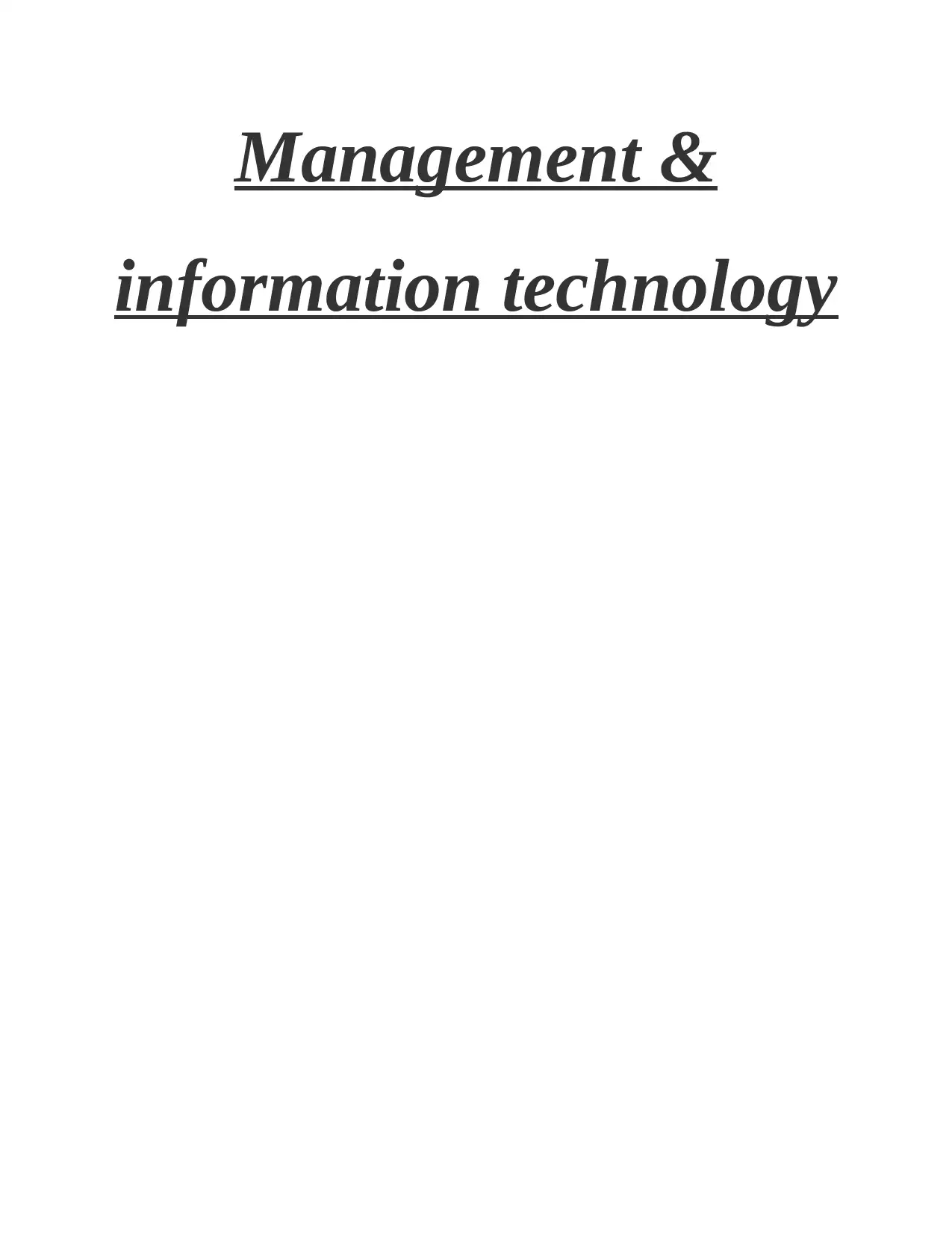
Management &
information technology
information technology
Paraphrase This Document
Need a fresh take? Get an instant paraphrase of this document with our AI Paraphraser
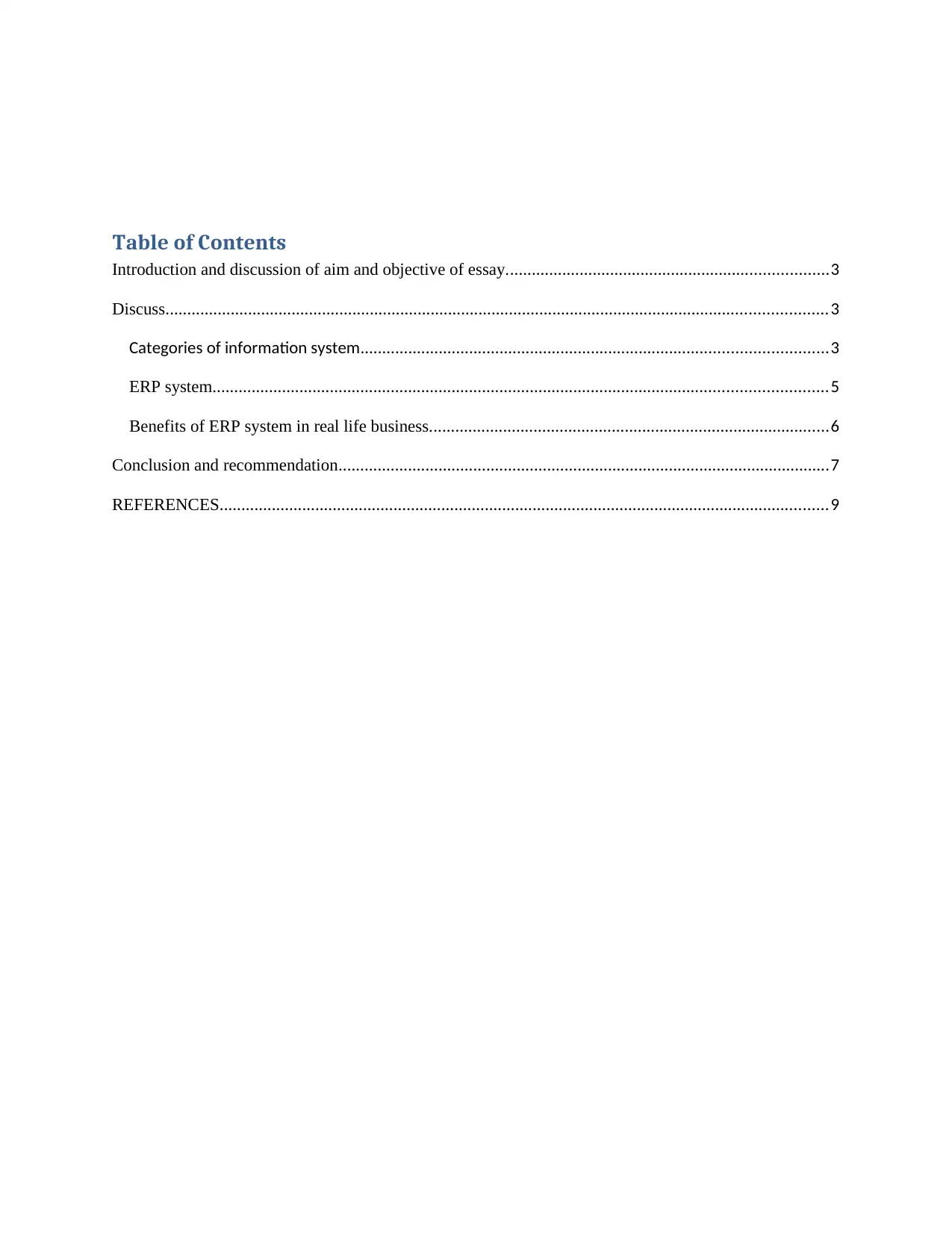
Table of Contents
Introduction and discussion of aim and objective of essay..........................................................................3
Discuss........................................................................................................................................................3
Categories of information system...........................................................................................................3
ERP system.............................................................................................................................................5
Benefits of ERP system in real life business............................................................................................6
Conclusion and recommendation.................................................................................................................7
REFERENCES............................................................................................................................................9
Introduction and discussion of aim and objective of essay..........................................................................3
Discuss........................................................................................................................................................3
Categories of information system...........................................................................................................3
ERP system.............................................................................................................................................5
Benefits of ERP system in real life business............................................................................................6
Conclusion and recommendation.................................................................................................................7
REFERENCES............................................................................................................................................9
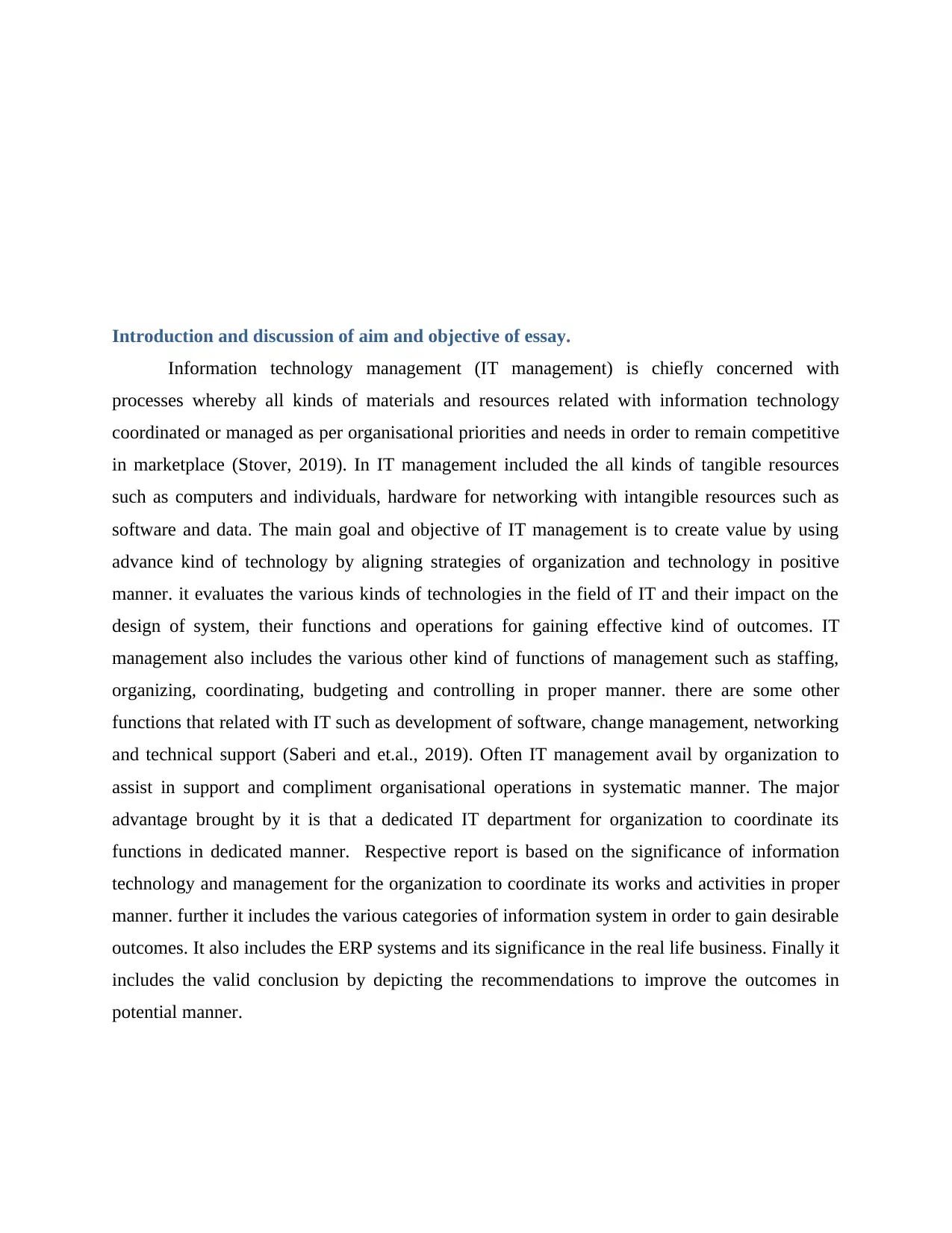
Introduction and discussion of aim and objective of essay.
Information technology management (IT management) is chiefly concerned with
processes whereby all kinds of materials and resources related with information technology
coordinated or managed as per organisational priorities and needs in order to remain competitive
in marketplace (Stover, 2019). In IT management included the all kinds of tangible resources
such as computers and individuals, hardware for networking with intangible resources such as
software and data. The main goal and objective of IT management is to create value by using
advance kind of technology by aligning strategies of organization and technology in positive
manner. it evaluates the various kinds of technologies in the field of IT and their impact on the
design of system, their functions and operations for gaining effective kind of outcomes. IT
management also includes the various other kind of functions of management such as staffing,
organizing, coordinating, budgeting and controlling in proper manner. there are some other
functions that related with IT such as development of software, change management, networking
and technical support (Saberi and et.al., 2019). Often IT management avail by organization to
assist in support and compliment organisational operations in systematic manner. The major
advantage brought by it is that a dedicated IT department for organization to coordinate its
functions in dedicated manner. Respective report is based on the significance of information
technology and management for the organization to coordinate its works and activities in proper
manner. further it includes the various categories of information system in order to gain desirable
outcomes. It also includes the ERP systems and its significance in the real life business. Finally it
includes the valid conclusion by depicting the recommendations to improve the outcomes in
potential manner.
Information technology management (IT management) is chiefly concerned with
processes whereby all kinds of materials and resources related with information technology
coordinated or managed as per organisational priorities and needs in order to remain competitive
in marketplace (Stover, 2019). In IT management included the all kinds of tangible resources
such as computers and individuals, hardware for networking with intangible resources such as
software and data. The main goal and objective of IT management is to create value by using
advance kind of technology by aligning strategies of organization and technology in positive
manner. it evaluates the various kinds of technologies in the field of IT and their impact on the
design of system, their functions and operations for gaining effective kind of outcomes. IT
management also includes the various other kind of functions of management such as staffing,
organizing, coordinating, budgeting and controlling in proper manner. there are some other
functions that related with IT such as development of software, change management, networking
and technical support (Saberi and et.al., 2019). Often IT management avail by organization to
assist in support and compliment organisational operations in systematic manner. The major
advantage brought by it is that a dedicated IT department for organization to coordinate its
functions in dedicated manner. Respective report is based on the significance of information
technology and management for the organization to coordinate its works and activities in proper
manner. further it includes the various categories of information system in order to gain desirable
outcomes. It also includes the ERP systems and its significance in the real life business. Finally it
includes the valid conclusion by depicting the recommendations to improve the outcomes in
potential manner.
⊘ This is a preview!⊘
Do you want full access?
Subscribe today to unlock all pages.

Trusted by 1+ million students worldwide
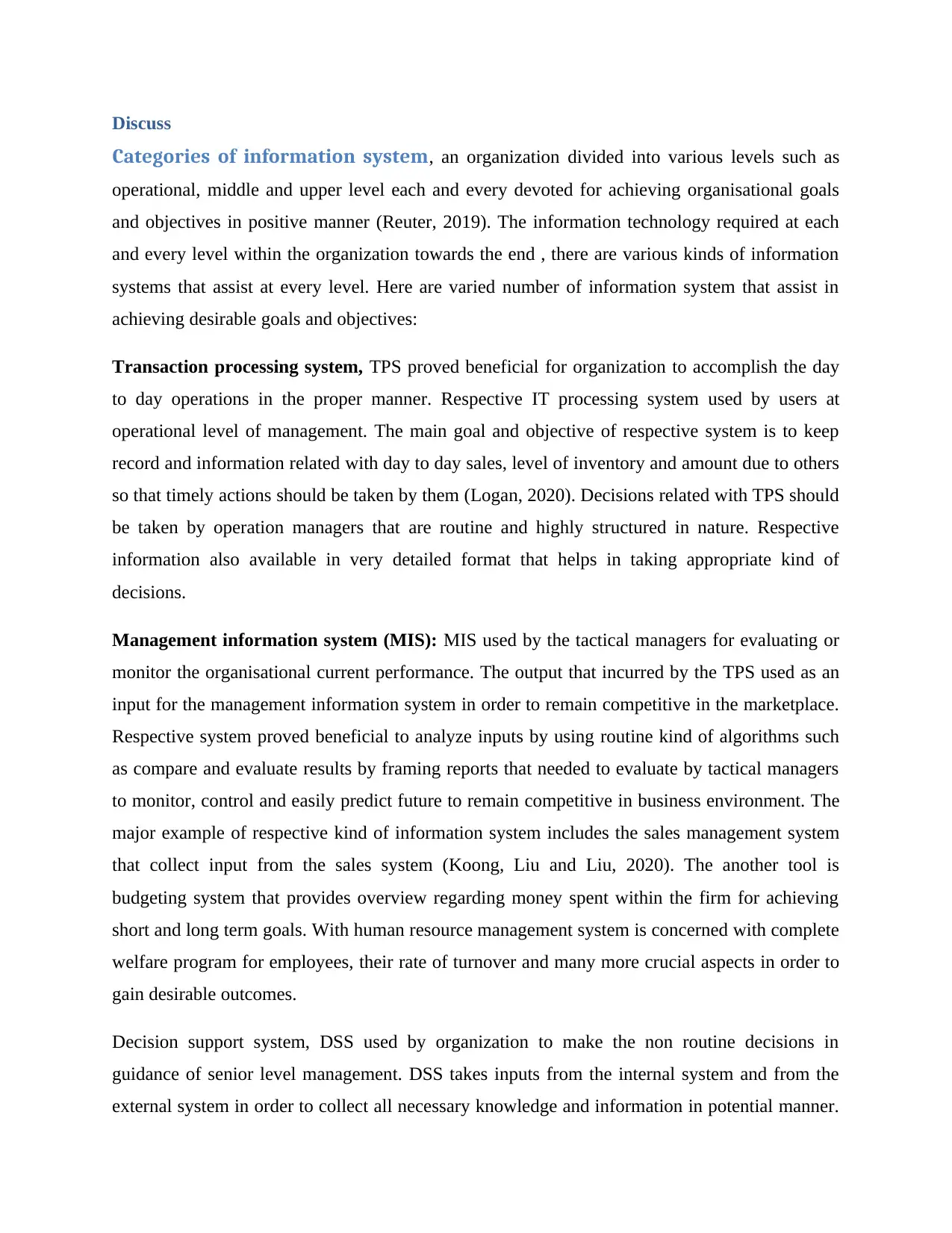
Discuss
Categories of information system, an organization divided into various levels such as
operational, middle and upper level each and every devoted for achieving organisational goals
and objectives in positive manner (Reuter, 2019). The information technology required at each
and every level within the organization towards the end , there are various kinds of information
systems that assist at every level. Here are varied number of information system that assist in
achieving desirable goals and objectives:
Transaction processing system, TPS proved beneficial for organization to accomplish the day
to day operations in the proper manner. Respective IT processing system used by users at
operational level of management. The main goal and objective of respective system is to keep
record and information related with day to day sales, level of inventory and amount due to others
so that timely actions should be taken by them (Logan, 2020). Decisions related with TPS should
be taken by operation managers that are routine and highly structured in nature. Respective
information also available in very detailed format that helps in taking appropriate kind of
decisions.
Management information system (MIS): MIS used by the tactical managers for evaluating or
monitor the organisational current performance. The output that incurred by the TPS used as an
input for the management information system in order to remain competitive in the marketplace.
Respective system proved beneficial to analyze inputs by using routine kind of algorithms such
as compare and evaluate results by framing reports that needed to evaluate by tactical managers
to monitor, control and easily predict future to remain competitive in business environment. The
major example of respective kind of information system includes the sales management system
that collect input from the sales system (Koong, Liu and Liu, 2020). The another tool is
budgeting system that provides overview regarding money spent within the firm for achieving
short and long term goals. With human resource management system is concerned with complete
welfare program for employees, their rate of turnover and many more crucial aspects in order to
gain desirable outcomes.
Decision support system, DSS used by organization to make the non routine decisions in
guidance of senior level management. DSS takes inputs from the internal system and from the
external system in order to collect all necessary knowledge and information in potential manner.
Categories of information system, an organization divided into various levels such as
operational, middle and upper level each and every devoted for achieving organisational goals
and objectives in positive manner (Reuter, 2019). The information technology required at each
and every level within the organization towards the end , there are various kinds of information
systems that assist at every level. Here are varied number of information system that assist in
achieving desirable goals and objectives:
Transaction processing system, TPS proved beneficial for organization to accomplish the day
to day operations in the proper manner. Respective IT processing system used by users at
operational level of management. The main goal and objective of respective system is to keep
record and information related with day to day sales, level of inventory and amount due to others
so that timely actions should be taken by them (Logan, 2020). Decisions related with TPS should
be taken by operation managers that are routine and highly structured in nature. Respective
information also available in very detailed format that helps in taking appropriate kind of
decisions.
Management information system (MIS): MIS used by the tactical managers for evaluating or
monitor the organisational current performance. The output that incurred by the TPS used as an
input for the management information system in order to remain competitive in the marketplace.
Respective system proved beneficial to analyze inputs by using routine kind of algorithms such
as compare and evaluate results by framing reports that needed to evaluate by tactical managers
to monitor, control and easily predict future to remain competitive in business environment. The
major example of respective kind of information system includes the sales management system
that collect input from the sales system (Koong, Liu and Liu, 2020). The another tool is
budgeting system that provides overview regarding money spent within the firm for achieving
short and long term goals. With human resource management system is concerned with complete
welfare program for employees, their rate of turnover and many more crucial aspects in order to
gain desirable outcomes.
Decision support system, DSS used by organization to make the non routine decisions in
guidance of senior level management. DSS takes inputs from the internal system and from the
external system in order to collect all necessary knowledge and information in potential manner.
Paraphrase This Document
Need a fresh take? Get an instant paraphrase of this document with our AI Paraphraser
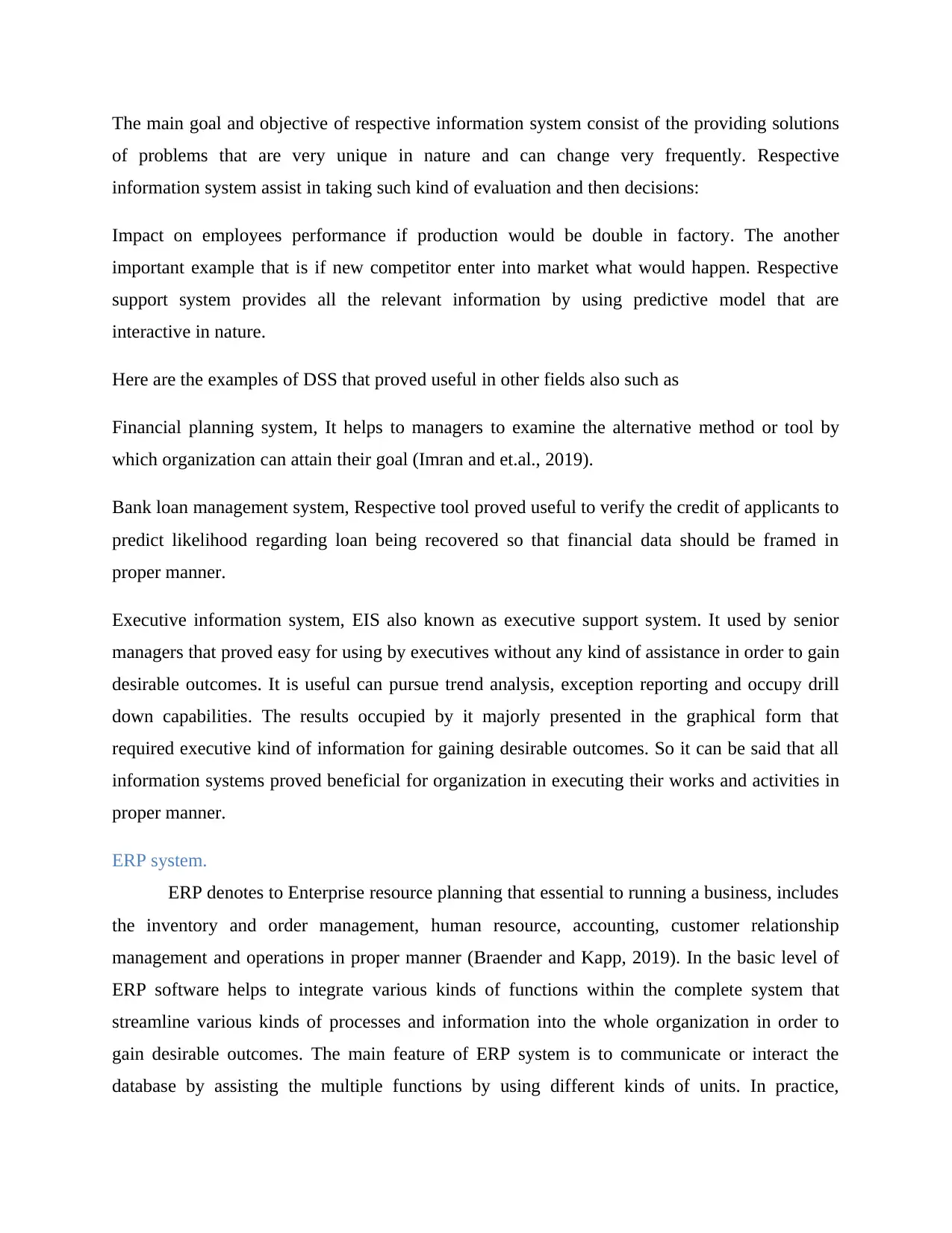
The main goal and objective of respective information system consist of the providing solutions
of problems that are very unique in nature and can change very frequently. Respective
information system assist in taking such kind of evaluation and then decisions:
Impact on employees performance if production would be double in factory. The another
important example that is if new competitor enter into market what would happen. Respective
support system provides all the relevant information by using predictive model that are
interactive in nature.
Here are the examples of DSS that proved useful in other fields also such as
Financial planning system, It helps to managers to examine the alternative method or tool by
which organization can attain their goal (Imran and et.al., 2019).
Bank loan management system, Respective tool proved useful to verify the credit of applicants to
predict likelihood regarding loan being recovered so that financial data should be framed in
proper manner.
Executive information system, EIS also known as executive support system. It used by senior
managers that proved easy for using by executives without any kind of assistance in order to gain
desirable outcomes. It is useful can pursue trend analysis, exception reporting and occupy drill
down capabilities. The results occupied by it majorly presented in the graphical form that
required executive kind of information for gaining desirable outcomes. So it can be said that all
information systems proved beneficial for organization in executing their works and activities in
proper manner.
ERP system.
ERP denotes to Enterprise resource planning that essential to running a business, includes
the inventory and order management, human resource, accounting, customer relationship
management and operations in proper manner (Braender and Kapp, 2019). In the basic level of
ERP software helps to integrate various kinds of functions within the complete system that
streamline various kinds of processes and information into the whole organization in order to
gain desirable outcomes. The main feature of ERP system is to communicate or interact the
database by assisting the multiple functions by using different kinds of units. In practice,
of problems that are very unique in nature and can change very frequently. Respective
information system assist in taking such kind of evaluation and then decisions:
Impact on employees performance if production would be double in factory. The another
important example that is if new competitor enter into market what would happen. Respective
support system provides all the relevant information by using predictive model that are
interactive in nature.
Here are the examples of DSS that proved useful in other fields also such as
Financial planning system, It helps to managers to examine the alternative method or tool by
which organization can attain their goal (Imran and et.al., 2019).
Bank loan management system, Respective tool proved useful to verify the credit of applicants to
predict likelihood regarding loan being recovered so that financial data should be framed in
proper manner.
Executive information system, EIS also known as executive support system. It used by senior
managers that proved easy for using by executives without any kind of assistance in order to gain
desirable outcomes. It is useful can pursue trend analysis, exception reporting and occupy drill
down capabilities. The results occupied by it majorly presented in the graphical form that
required executive kind of information for gaining desirable outcomes. So it can be said that all
information systems proved beneficial for organization in executing their works and activities in
proper manner.
ERP system.
ERP denotes to Enterprise resource planning that essential to running a business, includes
the inventory and order management, human resource, accounting, customer relationship
management and operations in proper manner (Braender and Kapp, 2019). In the basic level of
ERP software helps to integrate various kinds of functions within the complete system that
streamline various kinds of processes and information into the whole organization in order to
gain desirable outcomes. The main feature of ERP system is to communicate or interact the
database by assisting the multiple functions by using different kinds of units. In practice,
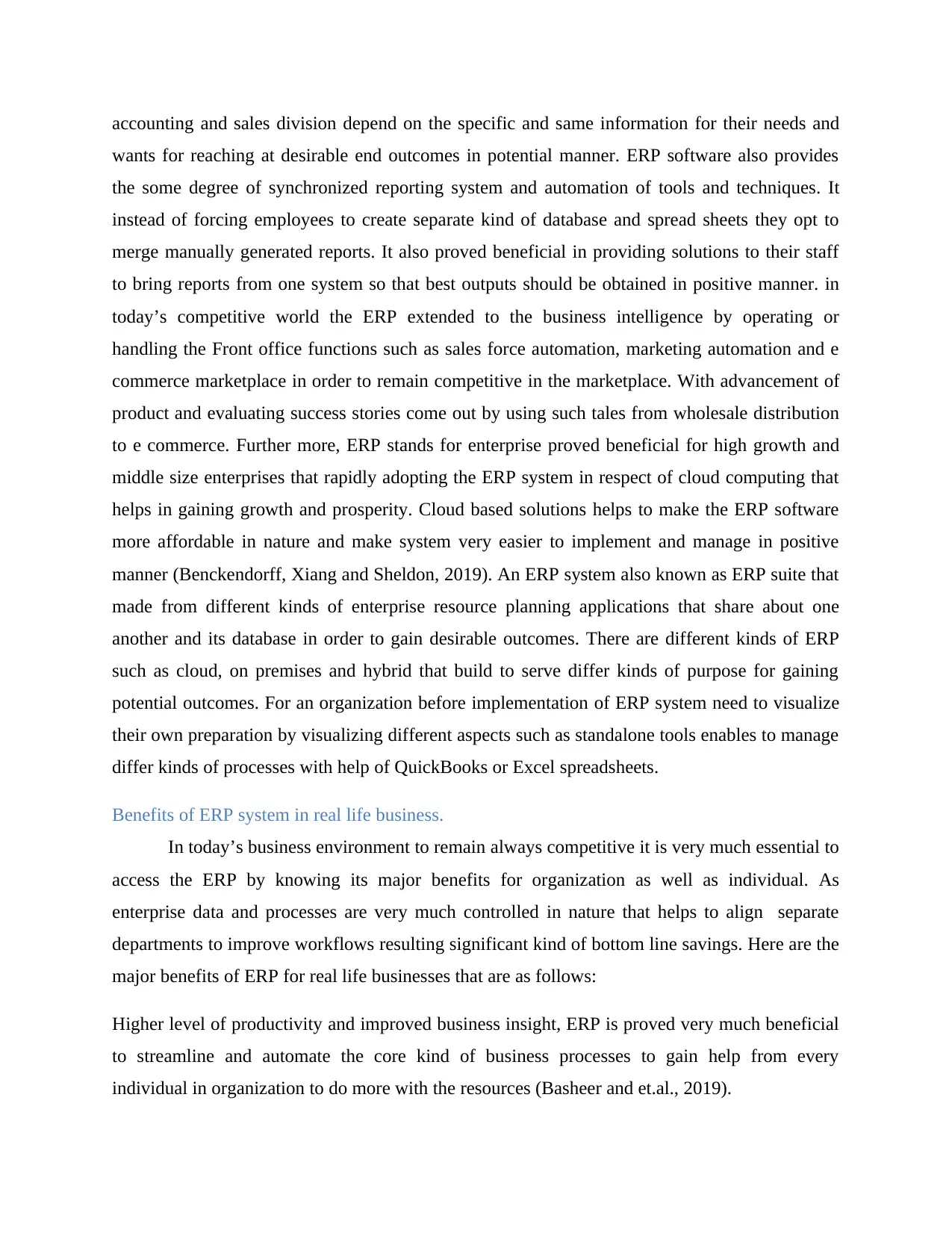
accounting and sales division depend on the specific and same information for their needs and
wants for reaching at desirable end outcomes in potential manner. ERP software also provides
the some degree of synchronized reporting system and automation of tools and techniques. It
instead of forcing employees to create separate kind of database and spread sheets they opt to
merge manually generated reports. It also proved beneficial in providing solutions to their staff
to bring reports from one system so that best outputs should be obtained in positive manner. in
today’s competitive world the ERP extended to the business intelligence by operating or
handling the Front office functions such as sales force automation, marketing automation and e
commerce marketplace in order to remain competitive in the marketplace. With advancement of
product and evaluating success stories come out by using such tales from wholesale distribution
to e commerce. Further more, ERP stands for enterprise proved beneficial for high growth and
middle size enterprises that rapidly adopting the ERP system in respect of cloud computing that
helps in gaining growth and prosperity. Cloud based solutions helps to make the ERP software
more affordable in nature and make system very easier to implement and manage in positive
manner (Benckendorff, Xiang and Sheldon, 2019). An ERP system also known as ERP suite that
made from different kinds of enterprise resource planning applications that share about one
another and its database in order to gain desirable outcomes. There are different kinds of ERP
such as cloud, on premises and hybrid that build to serve differ kinds of purpose for gaining
potential outcomes. For an organization before implementation of ERP system need to visualize
their own preparation by visualizing different aspects such as standalone tools enables to manage
differ kinds of processes with help of QuickBooks or Excel spreadsheets.
Benefits of ERP system in real life business.
In today’s business environment to remain always competitive it is very much essential to
access the ERP by knowing its major benefits for organization as well as individual. As
enterprise data and processes are very much controlled in nature that helps to align separate
departments to improve workflows resulting significant kind of bottom line savings. Here are the
major benefits of ERP for real life businesses that are as follows:
Higher level of productivity and improved business insight, ERP is proved very much beneficial
to streamline and automate the core kind of business processes to gain help from every
individual in organization to do more with the resources (Basheer and et.al., 2019).
wants for reaching at desirable end outcomes in potential manner. ERP software also provides
the some degree of synchronized reporting system and automation of tools and techniques. It
instead of forcing employees to create separate kind of database and spread sheets they opt to
merge manually generated reports. It also proved beneficial in providing solutions to their staff
to bring reports from one system so that best outputs should be obtained in positive manner. in
today’s competitive world the ERP extended to the business intelligence by operating or
handling the Front office functions such as sales force automation, marketing automation and e
commerce marketplace in order to remain competitive in the marketplace. With advancement of
product and evaluating success stories come out by using such tales from wholesale distribution
to e commerce. Further more, ERP stands for enterprise proved beneficial for high growth and
middle size enterprises that rapidly adopting the ERP system in respect of cloud computing that
helps in gaining growth and prosperity. Cloud based solutions helps to make the ERP software
more affordable in nature and make system very easier to implement and manage in positive
manner (Benckendorff, Xiang and Sheldon, 2019). An ERP system also known as ERP suite that
made from different kinds of enterprise resource planning applications that share about one
another and its database in order to gain desirable outcomes. There are different kinds of ERP
such as cloud, on premises and hybrid that build to serve differ kinds of purpose for gaining
potential outcomes. For an organization before implementation of ERP system need to visualize
their own preparation by visualizing different aspects such as standalone tools enables to manage
differ kinds of processes with help of QuickBooks or Excel spreadsheets.
Benefits of ERP system in real life business.
In today’s business environment to remain always competitive it is very much essential to
access the ERP by knowing its major benefits for organization as well as individual. As
enterprise data and processes are very much controlled in nature that helps to align separate
departments to improve workflows resulting significant kind of bottom line savings. Here are the
major benefits of ERP for real life businesses that are as follows:
Higher level of productivity and improved business insight, ERP is proved very much beneficial
to streamline and automate the core kind of business processes to gain help from every
individual in organization to do more with the resources (Basheer and et.al., 2019).
⊘ This is a preview!⊘
Do you want full access?
Subscribe today to unlock all pages.

Trusted by 1+ million students worldwide
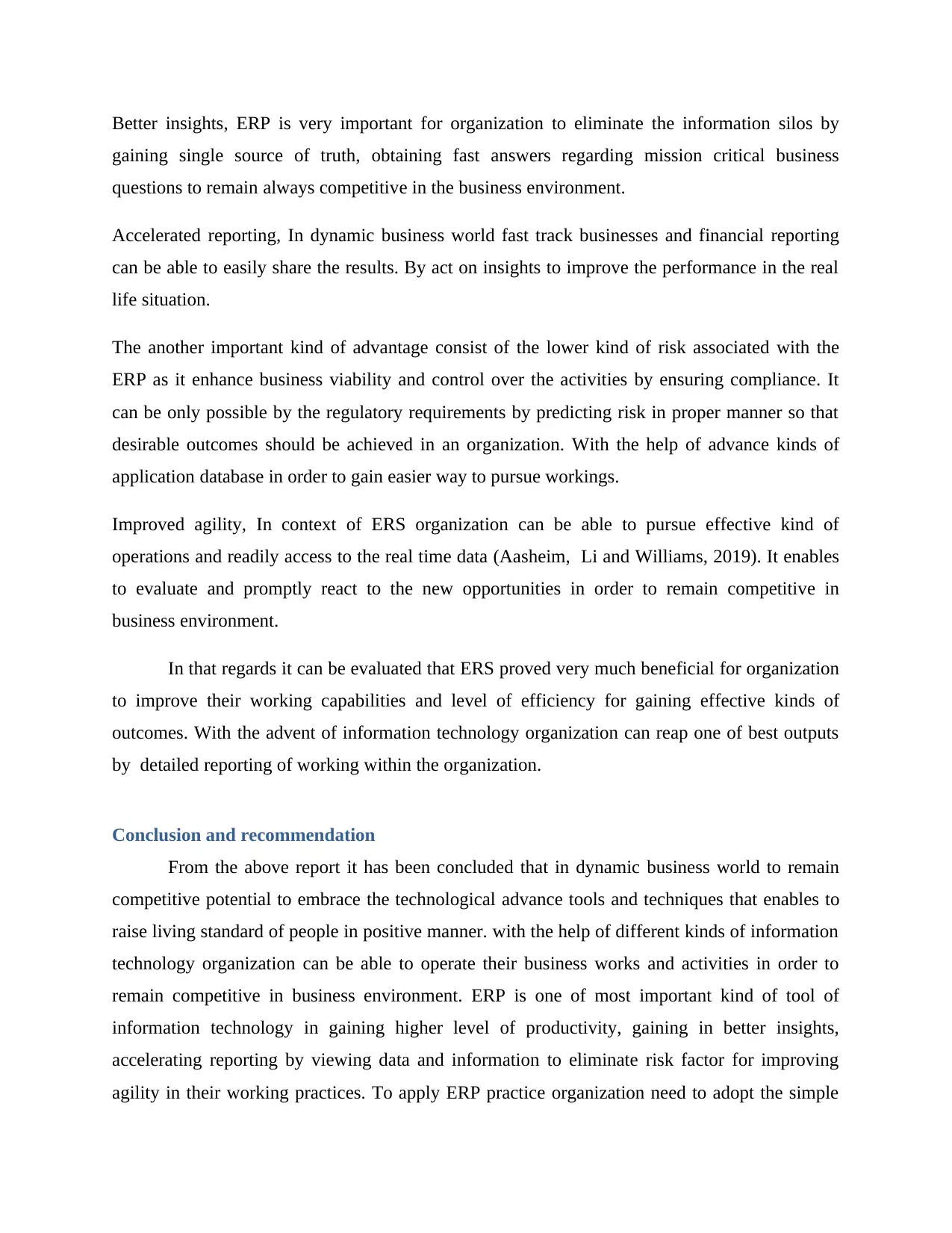
Better insights, ERP is very important for organization to eliminate the information silos by
gaining single source of truth, obtaining fast answers regarding mission critical business
questions to remain always competitive in the business environment.
Accelerated reporting, In dynamic business world fast track businesses and financial reporting
can be able to easily share the results. By act on insights to improve the performance in the real
life situation.
The another important kind of advantage consist of the lower kind of risk associated with the
ERP as it enhance business viability and control over the activities by ensuring compliance. It
can be only possible by the regulatory requirements by predicting risk in proper manner so that
desirable outcomes should be achieved in an organization. With the help of advance kinds of
application database in order to gain easier way to pursue workings.
Improved agility, In context of ERS organization can be able to pursue effective kind of
operations and readily access to the real time data (Aasheim, Li and Williams, 2019). It enables
to evaluate and promptly react to the new opportunities in order to remain competitive in
business environment.
In that regards it can be evaluated that ERS proved very much beneficial for organization
to improve their working capabilities and level of efficiency for gaining effective kinds of
outcomes. With the advent of information technology organization can reap one of best outputs
by detailed reporting of working within the organization.
Conclusion and recommendation
From the above report it has been concluded that in dynamic business world to remain
competitive potential to embrace the technological advance tools and techniques that enables to
raise living standard of people in positive manner. with the help of different kinds of information
technology organization can be able to operate their business works and activities in order to
remain competitive in business environment. ERP is one of most important kind of tool of
information technology in gaining higher level of productivity, gaining in better insights,
accelerating reporting by viewing data and information to eliminate risk factor for improving
agility in their working practices. To apply ERP practice organization need to adopt the simple
gaining single source of truth, obtaining fast answers regarding mission critical business
questions to remain always competitive in the business environment.
Accelerated reporting, In dynamic business world fast track businesses and financial reporting
can be able to easily share the results. By act on insights to improve the performance in the real
life situation.
The another important kind of advantage consist of the lower kind of risk associated with the
ERP as it enhance business viability and control over the activities by ensuring compliance. It
can be only possible by the regulatory requirements by predicting risk in proper manner so that
desirable outcomes should be achieved in an organization. With the help of advance kinds of
application database in order to gain easier way to pursue workings.
Improved agility, In context of ERS organization can be able to pursue effective kind of
operations and readily access to the real time data (Aasheim, Li and Williams, 2019). It enables
to evaluate and promptly react to the new opportunities in order to remain competitive in
business environment.
In that regards it can be evaluated that ERS proved very much beneficial for organization
to improve their working capabilities and level of efficiency for gaining effective kinds of
outcomes. With the advent of information technology organization can reap one of best outputs
by detailed reporting of working within the organization.
Conclusion and recommendation
From the above report it has been concluded that in dynamic business world to remain
competitive potential to embrace the technological advance tools and techniques that enables to
raise living standard of people in positive manner. with the help of different kinds of information
technology organization can be able to operate their business works and activities in order to
remain competitive in business environment. ERP is one of most important kind of tool of
information technology in gaining higher level of productivity, gaining in better insights,
accelerating reporting by viewing data and information to eliminate risk factor for improving
agility in their working practices. To apply ERP practice organization need to adopt the simple
Paraphrase This Document
Need a fresh take? Get an instant paraphrase of this document with our AI Paraphraser
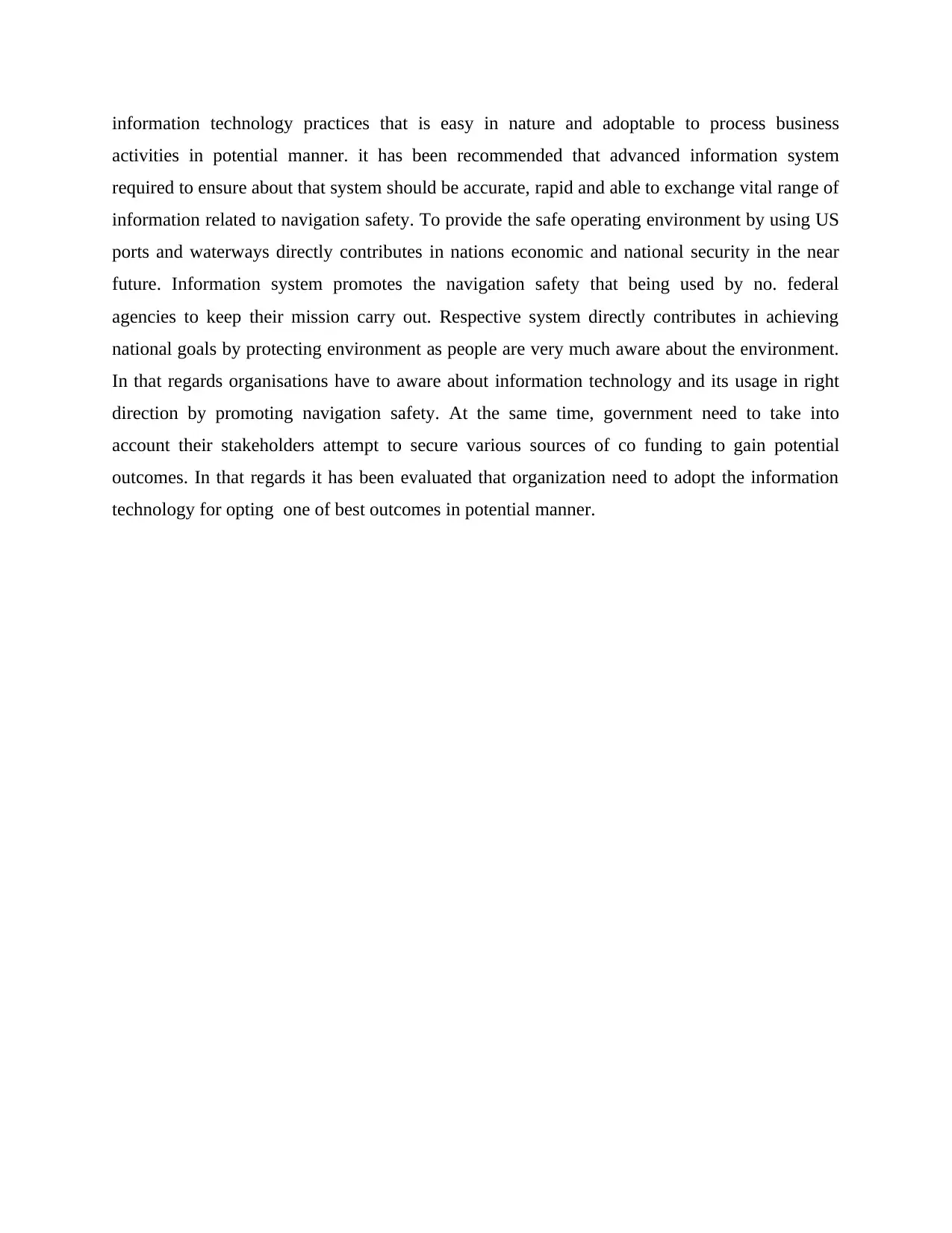
information technology practices that is easy in nature and adoptable to process business
activities in potential manner. it has been recommended that advanced information system
required to ensure about that system should be accurate, rapid and able to exchange vital range of
information related to navigation safety. To provide the safe operating environment by using US
ports and waterways directly contributes in nations economic and national security in the near
future. Information system promotes the navigation safety that being used by no. federal
agencies to keep their mission carry out. Respective system directly contributes in achieving
national goals by protecting environment as people are very much aware about the environment.
In that regards organisations have to aware about information technology and its usage in right
direction by promoting navigation safety. At the same time, government need to take into
account their stakeholders attempt to secure various sources of co funding to gain potential
outcomes. In that regards it has been evaluated that organization need to adopt the information
technology for opting one of best outcomes in potential manner.
activities in potential manner. it has been recommended that advanced information system
required to ensure about that system should be accurate, rapid and able to exchange vital range of
information related to navigation safety. To provide the safe operating environment by using US
ports and waterways directly contributes in nations economic and national security in the near
future. Information system promotes the navigation safety that being used by no. federal
agencies to keep their mission carry out. Respective system directly contributes in achieving
national goals by protecting environment as people are very much aware about the environment.
In that regards organisations have to aware about information technology and its usage in right
direction by promoting navigation safety. At the same time, government need to take into
account their stakeholders attempt to secure various sources of co funding to gain potential
outcomes. In that regards it has been evaluated that organization need to adopt the information
technology for opting one of best outcomes in potential manner.

REFERENCES
Books and journals:
Books and journals:
⊘ This is a preview!⊘
Do you want full access?
Subscribe today to unlock all pages.

Trusted by 1+ million students worldwide
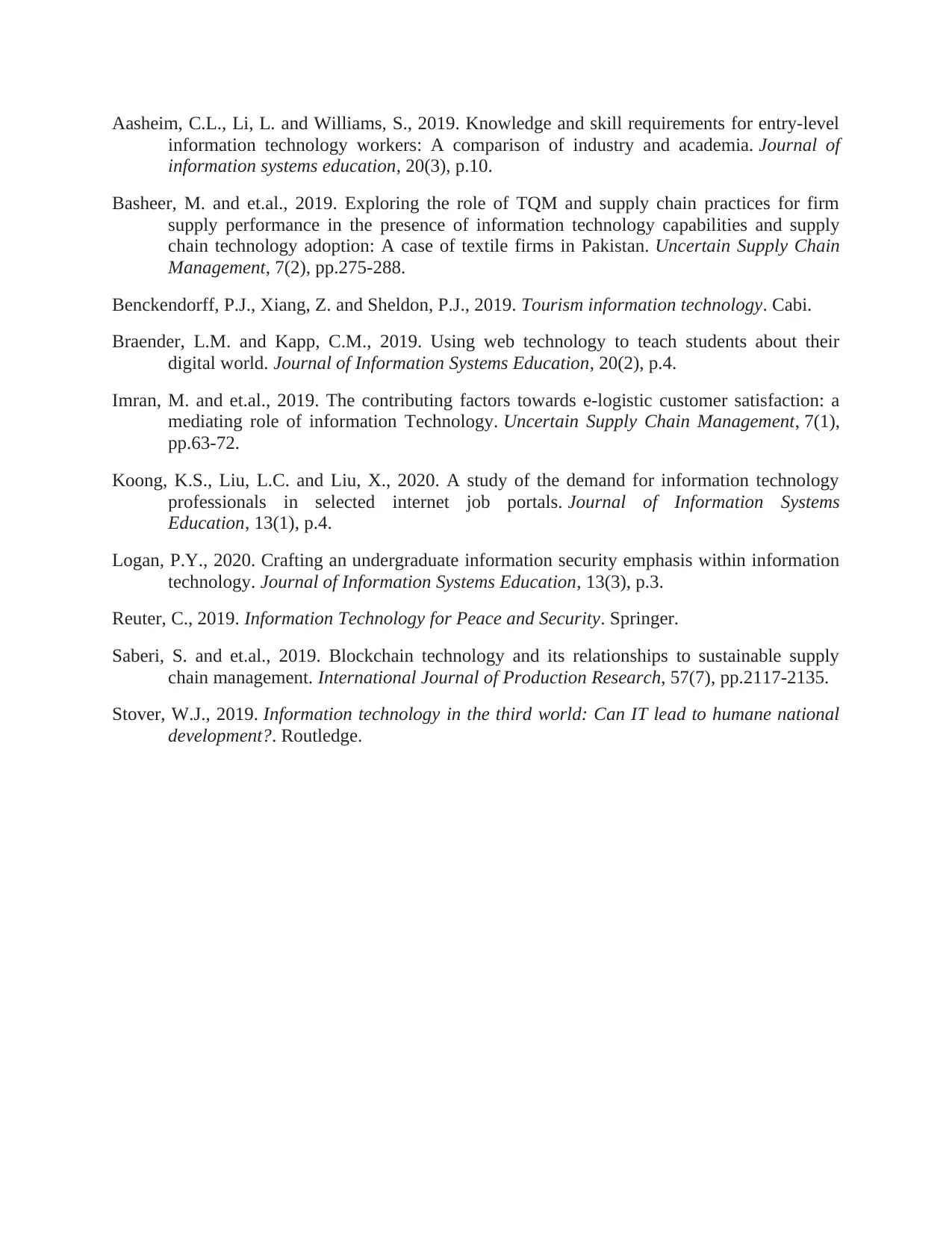
Aasheim, C.L., Li, L. and Williams, S., 2019. Knowledge and skill requirements for entry-level
information technology workers: A comparison of industry and academia. Journal of
information systems education, 20(3), p.10.
Basheer, M. and et.al., 2019. Exploring the role of TQM and supply chain practices for firm
supply performance in the presence of information technology capabilities and supply
chain technology adoption: A case of textile firms in Pakistan. Uncertain Supply Chain
Management, 7(2), pp.275-288.
Benckendorff, P.J., Xiang, Z. and Sheldon, P.J., 2019. Tourism information technology. Cabi.
Braender, L.M. and Kapp, C.M., 2019. Using web technology to teach students about their
digital world. Journal of Information Systems Education, 20(2), p.4.
Imran, M. and et.al., 2019. The contributing factors towards e-logistic customer satisfaction: a
mediating role of information Technology. Uncertain Supply Chain Management, 7(1),
pp.63-72.
Koong, K.S., Liu, L.C. and Liu, X., 2020. A study of the demand for information technology
professionals in selected internet job portals. Journal of Information Systems
Education, 13(1), p.4.
Logan, P.Y., 2020. Crafting an undergraduate information security emphasis within information
technology. Journal of Information Systems Education, 13(3), p.3.
Reuter, C., 2019. Information Technology for Peace and Security. Springer.
Saberi, S. and et.al., 2019. Blockchain technology and its relationships to sustainable supply
chain management. International Journal of Production Research, 57(7), pp.2117-2135.
Stover, W.J., 2019. Information technology in the third world: Can IT lead to humane national
development?. Routledge.
information technology workers: A comparison of industry and academia. Journal of
information systems education, 20(3), p.10.
Basheer, M. and et.al., 2019. Exploring the role of TQM and supply chain practices for firm
supply performance in the presence of information technology capabilities and supply
chain technology adoption: A case of textile firms in Pakistan. Uncertain Supply Chain
Management, 7(2), pp.275-288.
Benckendorff, P.J., Xiang, Z. and Sheldon, P.J., 2019. Tourism information technology. Cabi.
Braender, L.M. and Kapp, C.M., 2019. Using web technology to teach students about their
digital world. Journal of Information Systems Education, 20(2), p.4.
Imran, M. and et.al., 2019. The contributing factors towards e-logistic customer satisfaction: a
mediating role of information Technology. Uncertain Supply Chain Management, 7(1),
pp.63-72.
Koong, K.S., Liu, L.C. and Liu, X., 2020. A study of the demand for information technology
professionals in selected internet job portals. Journal of Information Systems
Education, 13(1), p.4.
Logan, P.Y., 2020. Crafting an undergraduate information security emphasis within information
technology. Journal of Information Systems Education, 13(3), p.3.
Reuter, C., 2019. Information Technology for Peace and Security. Springer.
Saberi, S. and et.al., 2019. Blockchain technology and its relationships to sustainable supply
chain management. International Journal of Production Research, 57(7), pp.2117-2135.
Stover, W.J., 2019. Information technology in the third world: Can IT lead to humane national
development?. Routledge.
1 out of 10
Related Documents
Your All-in-One AI-Powered Toolkit for Academic Success.
+13062052269
info@desklib.com
Available 24*7 on WhatsApp / Email
![[object Object]](/_next/static/media/star-bottom.7253800d.svg)
Unlock your academic potential
Copyright © 2020–2025 A2Z Services. All Rights Reserved. Developed and managed by ZUCOL.





